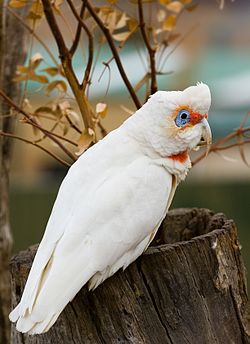As pests
Long-billed corellas are viewed as agricultural pests, particularly in western Victoria and Western Australia. They can cause significant crop damage, are known for tearing and playing with pieces of asphalt along roadsides, and even damaging power lines. Permits are regularly issued in Western Australia (and sometimes in Victoria) for the culling of this species. Within New South Wales, the corellas are the most common avian pest among sporting fields and golf courses, as they can dig holes in the ground up to 3 in across and 6 in deep. [5]
In July 2019, in a scene that was said to resemble a "horror movie", [12] [13] about 60 corellas in Adelaide, South Australia, [14] died in a suspected case of poisoning after "falling from the sky" wailing and bleeding from their mouths. At least 57 (95%) of the 60 birds were long-billed corellas, with a few short-billed corellas. It was hoped that whoever poisoned them could be traced, after toxicology tests were performed (which could nevertheless take several weeks to complete); in Australia, people are required to register if they purchase poisons, according to Sarah King (founder of Casper's Bird Rescue, who witnessed the deaths). [15] King also said that the poison was a slow-release variety that takes several painful weeks to kill the bird. Additionally, the local Alexandrina council had, previously, allowed for periodic culling of short-billed corellas due to crop damage, chewing on streetlights and wires, damaging infrastructure (such as buildings and sporting equipment), and unfairly outcompeting other native species of birds, insects, small mammals, and other organisms. [13]





